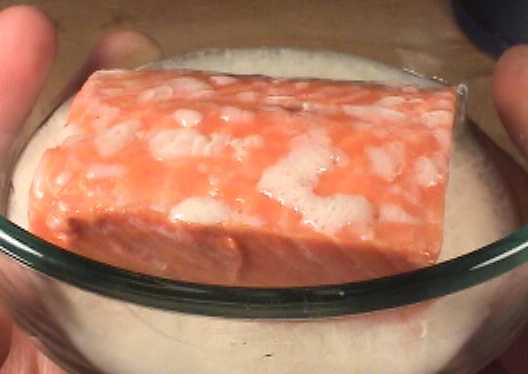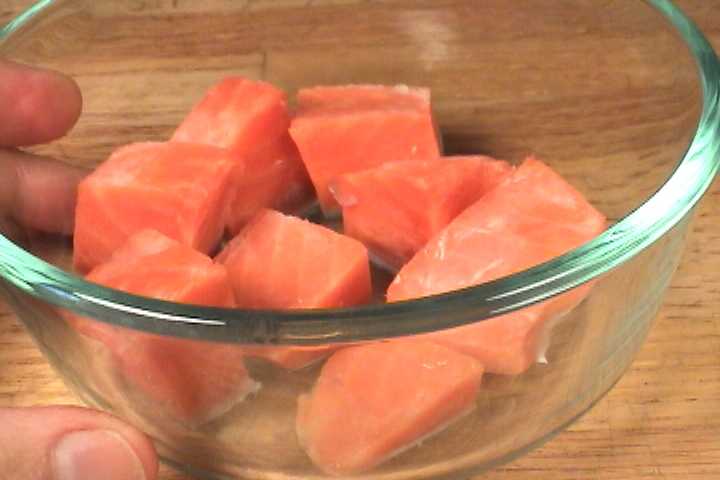1)
Salmon cooked in a glass bowl
I prefer lightly
cooked salmon
Trader Joe's sells frozen salmon, which I find to be a better
quality than the refrigerated salmon that is sold at ordinary markets.
However, the instructions that come with the Trader Joe's salmon advise
a internal temperature of 145° (63°C), and they suggest cooking the salmon
in an oven at 425°F (218°C).
My preferred method of cooking salmon is to put a raw piece in a bowl,
with nothing else. No liquid, no spices, no sauces, as in the photograph
below. Then I put the cover on the bowl, and put the bowl into a pan of
water that is held to between 50°C to 60°C (125°F to 140°F).
| I consider the salmon to be cooked as soon as white droplets start
forming on the surface of the meat and along the bottom of the bowl.
In this particular photo, I allowed the salmon to cook for quite a while,
so there is a lot of juice.
Note: unlike beef juice, salmon juice congeals into a
gel. |
|
 |
The salmon will not appear to have been cooked because it will
be incredibly juicy and tender, but it flakes just like over-cooked salmon,
as seen in the photograph below.
 The bottom of the bowl will have a layer of congealed, white
juice. When most people cook salmon, that juice is either burned, or it
drips between the gaps of a barbecue grill, or it splatters all over the
stove, but with this method of cooking salmon, all
of the juice is retained. Therefore, instead of eating the salmon
with a fork, you will want to eat it with a spoon
so
that you can pick up some of the juice with each bite. Also, I think this
low temperature salmon tastes so good that it doesn't need any sauce or
lemon juice. All I do is add a bit of salt to it. Sauces are
optional
when salmon is cooked like this.
When meat is cooked at high temperature, an enormous amount of juice
is lost, and so most people prefer to cook large
pieces of meat so that there is a center section that remains juicy. However,
with this lower temperature cooking method, none of the juice is lost or
burnt, so it is safe to cut meat into smaller pieces. The smaller pieces
are useful for making soup, or to speed up the cooking process. For example,
the photographs below show me cooking some small cubes of salmon. I begin
by putting the raw salmon cubes into a bowl, with nothing else.
 In this particular example, I did not let the salmon cubes
cook for as long a period of time as the larger piece of salmon in the
upper photograph. As a result, there are only a few white droplets on top
of the salmon, and the juice at the bottom of the bowl is not as white,
or as thick.
The photograph below shows that when touched with a fork, this
salmon, which appears raw, flakes apart, just like the over-cooked salmon.
Also, notice how incredibly juicy the meat is.
In the photograph below, I've eaten a few of the pieces, and
this makes it easier to see the white, congealed juice.
If you perfer the salmon to be more well done, don't
increase the temperature! Instead, just leave it in the hot
water for a longer period of time and wait until you see more of the white
droplets of juice on the surface.
Do you like the dark meat or skin
of salmon?
As I mentioned above, I think this low temperature salmon tastes
so good that I don't need any sauces or spices with it, but I don't like
the taste of the dark meat or the skin. Therefore, I eat the orange meat,
and leave the dark meat and the skin in the bowl. Then I combine the dark
meat and skin with a sauce or other food. For example, I like it with diced
and pickled cucumbers or watermelon, and here
are photos of how I have used the skin as one of the toppings for a
pizza with a sweet-and-sour feta cheese sauce rather than a tomato-based
sauce, thereby creating a "Salmon Dessert Pizza".
Why does canned
meat taste so different than fresh meat?
It is important to note that flavor of low temperature salmon,
and its texture, is completely different compared to canned
salmon. The same is true of albacore tuna. If you cook a piece of albacore
tuna at a low temperature, it will taste much better than canned tuna fish.
This also applies to canned turkey and chicken. I suppose
this concept applies to sardines, also, but I've never cooked a
raw sardine. What are these high temperatures doing to the meat?
|
|